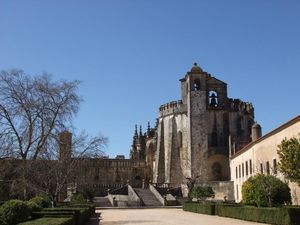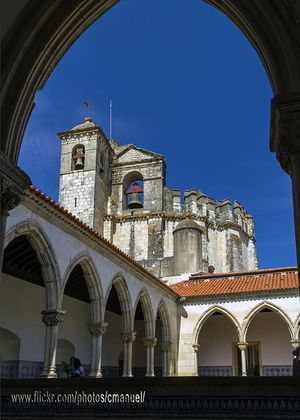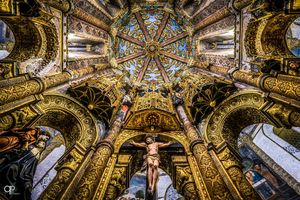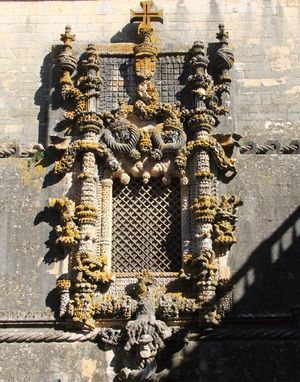
Convent of Christ, Tomar
Don’t miss visiting the Convent of Christ while staying in Tomar.
The Convent of Christ sits atop a hill, in the interior of the walls of the Castle of the Knights Templar, dominating the city of Tomar, Portugal.
Both the castle and convent were the headquarters of the Knights Templar until 1314 and of the Order of Christ from 1357 onwards. The castle was built in 1160, and the whole area is nowadays listed as World Heritage by the UNESCO.
The building of the Convent of Christ, partly directed by the renowned architect João de Castilho, extended from the 12th to the 17th century. Nowadays, the building itself can be considered a museum of the different architectural styles of Portuguese history: Romanic, Gothic, Manueline, Renaissance.
Some spots especially worth noting:
Templar Charola (Rotunda):
It was built in the 12th century, following the style of the Holy Sepulchre of Jerusalem. The rotunda of the Knights Templar is an octogonal building of two heights supported by eight pillars, a walk with a barrel vault and separated from the exterior by sixteen sides.
The interior is decorated with paintings by Portuguese artists and some wooden sculptures.
Main Cloister:
The most iconic and important cloister of the four present in the Convent of Christ. It was built between 1557 and 1566, mainly by Diogo de Torralva.
It’s known as Claustro dos Felipes (Cloister of the Philips) as an homage to Philip II who placed here the kingdom Crown in 1581.
The cloister is composed of two floors sustained by Tuscan columns on the lower floor and Ionic on the upper. The decoration is scarce and contrasts with the Manueline ornamentation of the nave. Although there are three windows, only two are visible. The first is to the right when entering the cloister. The most famous window, however, is located not here but in the Cloister of Santa Bárbara.
Chapter Window (A Janela do Capítulo):
The most incredible ornamentation work of Manueline style in Portugal is the Chapter Window. Projected by architect Diogo de Arruda, it was sculpted between 1510 and 1513 from the roots of a cork oak sustained here by the bust of a captain. The decoration climbs along two masts with several reliefs.
There are vegetable motifs, but also coral, ropes, seaweed, and chains.
The window is topped by the coat of arms of King D. Manuel II and the Cross of the Orden of Christ, also present in the balustrade around the boat. The window is tied with a rope from both towers, one of them also with a chain that represents the Order of the Jarreta.
To visit the convent in full, at least an hour is necessary. It’s possible to leave the car nearby the 17th century walls, in a private parking.
More information:
Location:
Castelo Templário de Tomar, Portugal.
Ticket price:
Simple Admission: 6 €.
Compound admission (World Heritage Route: Alcobaça, Batalha, and Convent of Christ): 15€
There are discounts for senior citizens over 65, large families, underage, and Youth Card holders.
Free admission on Sundays and Bank Holidays until 14:00.
Opening hours:
October through May from 9:00 to 17:30 (last admission at 17:00).
June through September from 9:00 to 18:30 (last admission at 18:00).
Closed on January 1st, Easter Sunday, May 1st, and December 25th.
Recommended Excursions:
Mapa Interactivo:
Tomar
What to see:
- Castle of the Knights Templarr
- Convent of Christ
- Igreja de São João Baptista Church
- Igreja de Santa Maria do Olival Church
- Santa Iria Convent
- Ermida de Nossa Senhora da Conceição Hermit
- Casa Manuel Guimarães House
- Estaus
- Capela de São Gregório Chapel
- Paços do Concelho (Former Town Hall)
- Sete Montes National Forest
- Mills and Wineries of “El Rei"
- Ermida de Nossa Senhora da Piedade Hermit
- Pegões Aqueduct
- Capela de São Lourenço Chapel
- Museums:
- Casa dos Cubos
- José-Augusto França Contemporary Art Museum
- São Francisco Convent and Museu dos Fósforos (Match Museum)
- Abrão Zacuto Synagogue and Portuguese-Hebrew Museum
- Lopes-Graça Museum
What to do:
Other worth-visiting nearby towns and cities:
Why "Portugal Travel"?
Portugal Travel is an organization of Portuguese agencies whose objectives are:
- ✓ To make Portugal, its culture and its heritage known.
- ✓ To promote sustainable tourism.
In collaboration with:
Escola Superior de Hotelaria e Turismo do Estoril
Turismo de Portugal
Copyright PortugalTravel.org © - All rights reserved.







